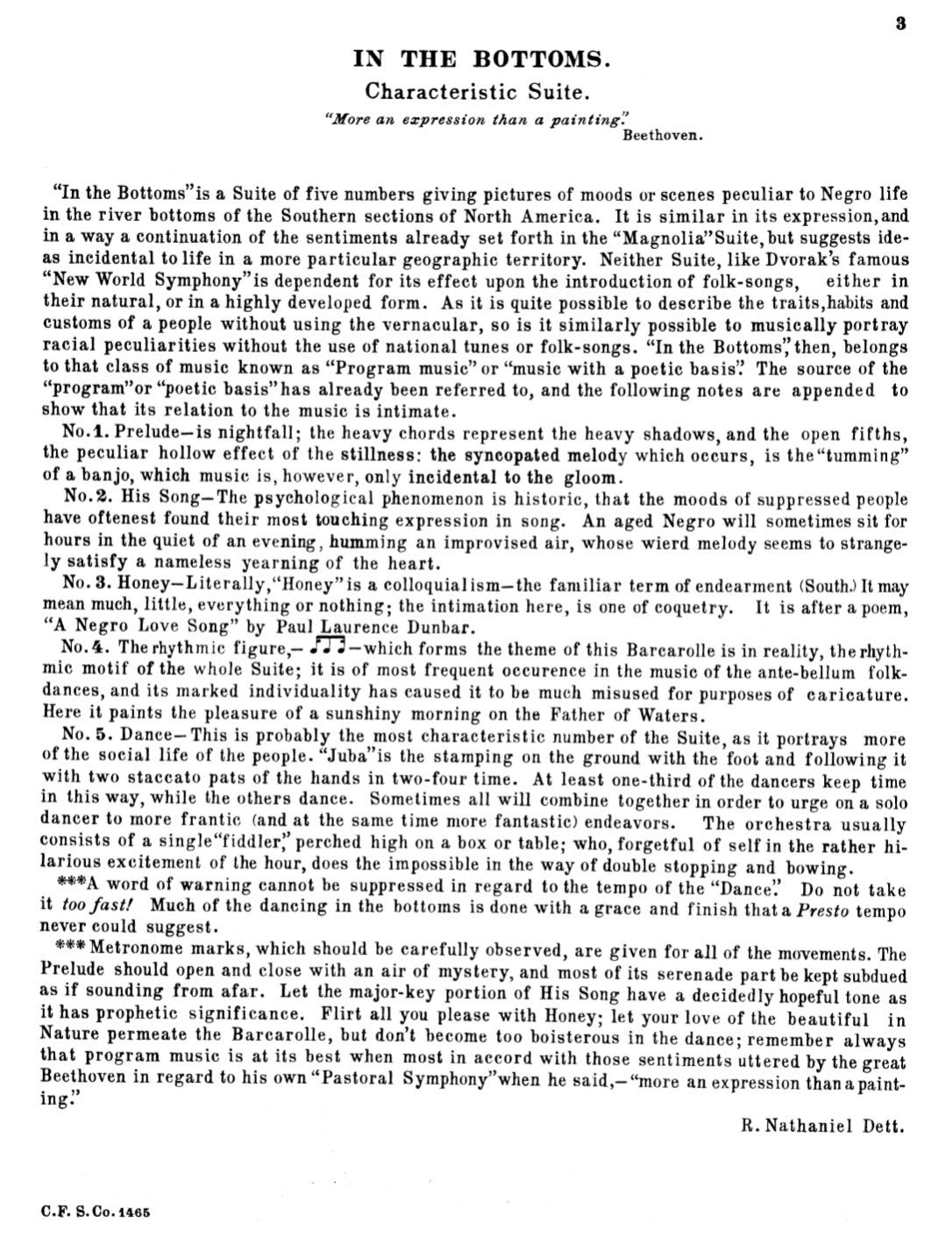In the Bottoms Suite, for tuba-euphonium octet
Instrumentation: tuba euphonium octet (euphonium 1-4, tuba 1-4)
Year Composed: 2020
Duration: 13’30”
Movements:
I. Prelude: Night
II. His Song
IV. Barcarolle: Morning
V. Dance: Juba
Originally composed for piano by R. Nathaniel Dett
Premiered June-August 2020 (virtual) by the COVID-19 Black All Star Ensemble. Premiered April 2021 (live) by Appalachian State Tuba-Euphonium Ensemble.
Program Notes:
When I heard this piece, I was fascinated by its orchestrational potential. The nearly complete suite transferred to tuba-euphonium ensemble quite well, given the versatility and range ability of the ensemble. In addition to Dett’s own program notes, I would like to highlight the following: The second movement utilizes some liberties in arranging rather than transcribing. The fourth movement is essentially a virtuosic solo-euphonium feature. At this time, I do not have an existing arrangement of movement 3 (Honey) but can arrange it if there is demand.
In the Bottoms: Introduction and Juba Dance, for wind band
Instrumentation: wind band
Year Composed: 2022
Originally composed for piano by R. Nathaniel Dett. Arrangement commissioned by the Black Composer Revival Consortium
Premiered December 2022
Program Notes:
In the Bottoms was written originally for piano by Robert Nathaniel Dett in 1913. This five-movement suite is meant to depict “negro life in the river bottoms.” For this arrangement, I took the introduction from the first and second movements of the piece, “Prelude (Night)” and “His Song.” The “Juba Dance'' is the last movement of the piece.
According to Wikipedia, the juba dance is an “African-American style of dance that involves stomping as well as slapping and patting the arms, legs, chest, and cheeks.” Typically, the dancers would form a circle to keep the rhythm and a solo dancer could get in the middle. Percussion instruments were often not allowed to be used by the slaves for fear of secret communication, so body percussion took their place. In the piece, the ostinato accompaniment line would be the equivalent of the rhythmic stomping and patting or clapping that would have taken place in a juba dance circle, while the melody would be sung or played on a fiddle.
In the Bottoms: Introduction and Juba Dance, for orchestra
Instrumentation: orchestra
Year Composed: 2022
Originally composed for piano by R. Nathaniel Dett. Arrangement commissioned by the Black Composer Revival Consortium
Premiered October 2022
Program Notes:
In the Bottoms was written originally for piano by Robert Nathaniel Dett in 1913. This five-movement suite is meant to depict “negro life in the river bottoms.” For this arrangement, I took the introduction from the first and second movements of the piece, “Prelude (Night)” and “His Song.” The “Juba Dance'' is the last movement of the piece.
According to Wikipedia, the juba dance is an “African-American style of dance that involves stomping as well as slapping and patting the arms, legs, chest, and cheeks.” Typically, the dancers would form a circle to keep the rhythm and a solo dancer could get in the middle. Percussion instruments were often not allowed to be used by the slaves for fear of secret communication, so body percussion took their place. In the piece, the ostinato accompaniment line would be the equivalent of the rhythmic stomping and patting or clapping that would have taken place in a juba dance circle, while the melody would be sung or played on a fiddle.
